Development of a Novel Double-Sulfate Composite Early Strength Agent to Improve the Hydration Hardening Properties of Portland Cement Paste
Abstract
:1. Introduction
2. Experimental Materials and Experimental Protocol
2.1. Experimental Materials
2.2. Experimental Protocol
2.2.1. Design Ratios
2.2.2. Preparation of Portland Cement Paste
2.2.3. Test for Setting Time
2.2.4. Test for Compressive Strength
2.2.5. Hydration Heat Release
2.2.6. XRD Analysis
2.2.7. TGA Analysis
2.2.8. SEM Analysis
2.2.9. MIP Analysis
3. Results and Discussion
3.1. Effect of the DSA on the Setting Time of Portland Cement Paste
3.2. Effect of the DSA on the Compressive Strength of Portland Cement Paste
3.3. Early Hydration Heat Evolution of Portland Cement Paste
3.4. Hydration Products Analysis
3.4.1. XRD Analysis
3.4.2. TG-DTG Analysis
3.5. Microstructure Observation
3.6. Pore Structure Evolution
3.7. Discussion
4. Conclusions
- (1)
- The early compressive strength of Portland cement paste at 3 d was significantly increased when using 1.0% of aluminum sulfate and 1.5% of sodium sulfate in combination, and the compressive strength at 28 d was also the best. The compressive strength at 3 d and 28 d were 40.4 MPa and 64.2 MPa, respectively, increasing 21.3% and 29.7% over the control group, 13.2% and 5.9% over the Al1.0% group, and 10.1% and 7.5% over Na1.5%, respectively.
- (2)
- Compared to the control group, the use of aluminum sulfate promoted the hydration of C3A, the reaction of Al3+, Ca2+, and (OH)− ions promoted the production of more AFt, while the reduction of Ca2+ and (OH)− ions rapidly promoted the hydration of C3S. The addition of sodium sulfate promoted the generation of a certain amount of CaSO4·H2O, thus facilitating the hydration of C3A to produce AFt, and the presence of Na+ and (OH)− ions combined to promote the solubility of C3S in the paste. When aluminum sulfate and sodium sulfate were used together, they synergistically promoted the hydration of C3A to produce AFt, facilitating the production of more AFt and the hydration of C3S and C2S to produce more C–S–H.
- (3)
- The synergistic use of 1.0% of aluminum sulfate and 1.5% of sodium sulfate resulted in the generation of more AFt in the Portland cement paste, which was cross-linked together to form the early skeleton of Portland cement paste base, and the products generated such as C–S–H, CaCO3 and CaSO4·H2O were filled in. Compared to the control group, the Al1.0% group, and the Na1.5% group, the Al1.0% + Na1.5% group resulted in a denser structure with reduced porosity, fewer harmful pores and more harmless pores, which allowed the Portland cement paste to exhibit a higher compressive strength.
Author Contributions
Funding
Institutional Review Board Statement
Informed Consent Statement
Data Availability Statement
Conflicts of Interest
References
- Aggoun, S.; Cheikh-Zouaoui, M.; Chikh, N.; Duval, R. Effect of some admixtures on the setting time and strength evolution of cement pastes at early ages. Constr. Build. Mater. 2008, 22, 106–110. [Google Scholar] [CrossRef]
- Wu, M.; Zhang, Y.; Jia, Y.; She, W.; Liu, G.; Yang, Z.; Zhang, Y.; Zhang, W.; Sun, W. Effects of sodium sulfate on the hydration and properties of lime-based low carbon cementitious materials. J. Clean. Prod. 2019, 220, 677–687. [Google Scholar] [CrossRef]
- Liu, S.; Shen, Y.; Wang, Y.; He, H.; Luo, S.; Huang, C. Synergistic use of sodium bicarbonate and aluminum sulfate to enhance the hydration and hardening properties of Portland cement paste. Constr. Build. Mater. 2021, 299, 124248. [Google Scholar] [CrossRef]
- Heren, Z.; Ölmez, H. The influence of ethanolamines on the hydration and mechanical properties of Portland cement. Cem. Concr. Res. 1996, 26, 701–705. [Google Scholar] [CrossRef]
- Bao, J.; Ren, Q.; Sun, L.; Ding, Y.; Oh, W.-C. Preparation of an Early Strengthening Agent for Concrete under Low-Temperature Conditions and Evaluation of Its Reaction Mechanism. Korean J. Mater. Res. 2021, 31, 195–208. [Google Scholar] [CrossRef]
- Lee, T.; Lee, J.; Choi, H.; Lee, D. The Effects of Fineness and TEA-Based Chemical Admixture on Early Strength Development of Concrete in Construction Site Applications. Materials 2020, 13, 2027. [Google Scholar] [CrossRef]
- Izotov, V.S.; Ibragimov, R.A. Hydration Products of Portland Cement Modified with a Complex Admixture. Inorg. Mater. 2015, 2, 87–190. [Google Scholar] [CrossRef]
- Izotov, V.S.; Ibragimov, R.A. Influence of additives-hardening accelerators on the properties of heavy concrete. Stroit. Mater. 2010, 3, 35–37. [Google Scholar]
- Fakhri, M.; Yousefian, F.; Amoosoltani, E.; Aliha, M.R.M.; Berto, F. Combined effects of recycled crumb rubber and silica fume on mechanical properties and mode I fracture toughness of self-compacting concrete. Fatigue Fract. Eng. Mater. Struct. 2021, 44, 2659–2673. [Google Scholar] [CrossRef]
- Fakhri, M.; Amoosoltani, E. Crack behavior analysis of roller compacted concrete mixtures containing reclaimed asphalt pavement and crumb rubber. Eng. Fract. Mech. 2017, 180, 43–59. [Google Scholar] [CrossRef]
- Fakhri, M.; Amoosoltani, E. The effect of Reclaimed Asphalt Pavement and crumb rubber on mechanical properties of Roller Compacted Concrete Pavement. Constr. Build. Mater. 2017, 137, 470–484. [Google Scholar] [CrossRef]
- Fakhri, M.; Saberi, K.F. The effect of waste rubber particles and silica fume on the mechanical properties of Roller Compacted Concrete Pavement. J. Clean. Prod. 2016, 129, 521–530. [Google Scholar] [CrossRef]
- Jiang, M.; Lv, X. Progress in Research and Application of early strength of concrete. Bull. Chin. Silic. Soc. 2014, 33, 2527–2533. [Google Scholar]
- Chen, S.; Du, Z.; Zhang, Z.; Zhang, H.; Xia, Z.; Feng, F. Effects of chloride on the early mechanical properties and microstructure of gangue-cemented paste backfill. Constr. Build. Mater. 2020, 235, 117504. [Google Scholar] [CrossRef]
- Wang, J.; Qian, C.; Qu, J.; Guo, J. Effect of lithium salt and nano nucleating agent on early hydration of cement based materials. Constr. Build. Mater. 2018, 174, 24–29. [Google Scholar] [CrossRef]
- Lu, C.; Yuan, S.; Cheng, P.; Liu, R. Mechanical properties of corroded steel bars in pre-cracked concrete suffering from chloride attack. Constr. Build. Mater. 2016, 123, 649–660. [Google Scholar] [CrossRef]
- Ren, G.; Tian, Z.; Wu, J.; Gao, X. Effects of combined accelerating admixtures on mechanical strength and microstructure of cement mortar. Constr. Build. Mater. 2021, 304, 124642. [Google Scholar] [CrossRef]
- Paglia, C.; Wombacher, F.; Böhni, H. The influence of alkali-free and alkaline shotcrete accelerators within cement systems: I. Characterization of the setting behavior. Cem. Concr. Res. 2001, 31, 913–918. [Google Scholar] [CrossRef]
- Prudêncio, L.R. Accelerating admixtures for shotcrete. Cem. Concr. Compos. 1998, 20, 213–219. [Google Scholar] [CrossRef]
- Yang, R.; He, T.; Guan, M.; Guo, X.; Xu, Y.; Xu, R.; Da, Y. Preparation and accelerating mechanism of aluminum sulfate-based alkali-free accelerating additive for sprayed concrete. Constr. Build. Mater. 2020, 234, 117334. [Google Scholar] [CrossRef]
- Liu, X.; Ma, B.; Tan, H.; Gu, B.; Zhang, T.; Chen, P.; Li, H.; Mei, J. Effect of aluminum sulfate on the hydration of Portland cement, tricalcium silicate and tricalcium aluminate. Constr. Build. Mater. 2020, 232, 117179. [Google Scholar] [CrossRef]
- Chen, C.; Sun, Z. Influence of Aluminum Sulfate on Hydration and Properties of Cement Pastes. J. Adv. Concr. Technol. 2018, 16, 522–530. [Google Scholar] [CrossRef]
- Li, H.; Xue, Z.; Liang, G.; Wu, K.; Dong, B.; Wang, W. Effect of C–S–H s-PCE and sodium sulfate on the hydration kinetics and mechanical properties of cement paste. Constr. Build. Mater. 2021, 266, 121096. [Google Scholar] [CrossRef]
- Zou, F.; Hu, C.; Wang, F.; Ruan, Y.; Hu, S. Enhancement of early-age strength of the high content fly ash blended cement paste by sodium sulfate and C–S–H seeds towards a greener binder. J. Clean. Prod. 2020, 244, 118566. [Google Scholar] [CrossRef]
- Fu, J.; Jones, A.M.; Bligh, M.W.; Holt, C.; Keyte, L.M.; Moghaddam, F.; Foster, S.J.; Waite, T.D. Mechanisms of enhancement in early hydration by sodium sulfate in a slag-cement blend—Insights from pore solution chemistry. Cem. Concr. Res. 2020, 135, 106110. [Google Scholar] [CrossRef]
- Zhao, Y.; Bai, H. Effect of early-strength admixture for concrete performance. LiaoNing Build. Mater. 2009, 7, 19–21. [Google Scholar]
- Tan, H.; Deng, X.; He, X.; Zhang, J.; Zhang, X.; Su, Y.; Yang, J. Compressive strength and hydration process of wet-grinded granulated blast-furnace slag activated by sodium sulfate and sodium carbonate. Cem. Concr. Compos. 2019, 97, 387–398. [Google Scholar] [CrossRef]
- Campos, A.; López, C.M.; Blanco, A.; Aguado, A. Effects of an internal sulfate attack and an alkali-aggregate reaction in a concrete dam. Constr. Build. Mater. 2018, 166, 668–683. [Google Scholar] [CrossRef] [Green Version]
- GB175-2007; Common Portland Cement. Standardization Administration of China: Beijing, China, 2017.
- GB/T 1346-2011; Test Methods for Water Requirement of Normal Consistency, Setting Time and Soundness of the Portland Cement. Standardization Administration of China: Beijing, China, 2011.
- GB/T 50081-2019; Standard for Test Method of Concrete Physical and Mechanical Properties. Standardization Administration of China: Beijing, China, 2019.
- Ma, B.; Zhang, T.; Tan, H.; Liu, X.; Mei, J.; Qi, H.; Jiang, W.; Zou, F. Effect of triisopropanolamine on compressive strength and hydration of cement-fly ash paste. Constr. Build. Mater. 2018, 179, 89–99. [Google Scholar] [CrossRef]
- Mei, J.; Tan, H.; Li, H.; Ma, B.; Liu, X.; Jiang, W.; Zhang, T.; Li, X. Effect of sodium sulfate and nano-SiO2 on hydration and microstructure of cementitious materials containing high volume fly ash under steam curing. Constr. Build. Mater. 2018, 163, 812–825. [Google Scholar] [CrossRef]
- Dai, J.; Wang, Q.; Lou, X.; Bao, X.; Zhang, B.; Wang, J.; Zhang, X. Solution calorimetry to assess effects of water-cement ratio and low temperature on hydration heat of cement. Constr. Build. Mater. 2021, 269, 121222. [Google Scholar] [CrossRef]
- Zhang, J.; Li, G.; Ye, W.; Chang, Y.; Liu, Q.; Song, Z. Effects of ordinary Portland cement on the early properties and hydration of calcium sulfoaluminate cement. Constr. Build. Mater. 2018, 186, 1144–1153. [Google Scholar] [CrossRef]
- Luo, S.Q.; Zhao, M.H.; Jiang, Z.Z.; Liu, S.H.; Yang, L.; Mao, Y.X.; Pan, C.G. Microwave preparation and carbonation properties of low-carbon cement. Constr. Build. Mater. 2021, 320, 126239. [Google Scholar] [CrossRef]
- Guan, X.; Liu, S.; Feng, C.; Qiu, M. The hardening behavior of γ-C2S binder using accelerated carbonation. Constr. Build. Mater. 2016, 114, 204–207. [Google Scholar] [CrossRef]
- Jain, J.; Neithalath, N. Analysis of calcium leaching behavior of plain and modified cement pastes in pure water. Cem. Concr. Compos. 2009, 31, 176–185. [Google Scholar] [CrossRef]
- Criado, M.; Jiménez, A.F.; Palomo, A. Effect of sodium sulfate on the alkali activation of fly ash. Cem. Concr. Compos. 2010, 32, 589–594. [Google Scholar] [CrossRef]
- Andrade Neto, J.S.; de Matos, P.R.; De la Torre, A.G.; Campos, C.E.M.; Gleize, P.J.P.; Monteiro, P.J.M.; Kirchheim, A.P. The role of sodium and sulfate sources on the rheology and hydration of C3A polymorphs. Cem. Concr. Res. 2022, 151, 106639. [Google Scholar] [CrossRef]
- Joseph, S.; Skibsted, J.; Cizer, Ö. A quantitative study of the C3A hydration. Cem. Concr. Res. 2019, 115, 145–159. [Google Scholar] [CrossRef]
- Quennoz, A.; Scrivener, K.L. Hydration of C3A–gypsum systems. Cem. Concr. Res. 2012, 42, 1032–1041. [Google Scholar] [CrossRef]
- Brykov, A.S.; Vasil Ev, A.S.; Mokeev, M.V. Hydration of portland cement in the presence of aluminum-containing setting accelerators. Russ. J. Appl. Chem. 2013, 86, 793–801. [Google Scholar] [CrossRef]
- He, H.; Wang, Y.; Wang, J. Compactness and hardened properties of machine-made sand mortar with aggregate micro fines. Constr. Build. Mater. 2020, 250, 118828. [Google Scholar] [CrossRef]
- Liu, S.; Zhang, H.; Wang, Y.; Gou, M. Carbon-dioxide-activated bonding material with low water demand. Adv. Cem. Res. 2021, 33, 193–196. [Google Scholar] [CrossRef]
- Liu, S.; Shen, P.; Xuan, D.; Li, L.; Sojobi, A.; Zhan, B.; Poon, C.S. A comparison of liquid-solid and gas-solid accelerated carbonation for enhancement of recycled concrete aggregate. Cem. Concr. Compos. 2021, 118, 103988. [Google Scholar] [CrossRef]
- Rashad, A.M.; Bai, Y.; Basheer, P.A.M.; Milestone, N.B.; Collier, N.C. Hydration and properties of sodium sulfate activated slag. Cem. Concr. Compos. 2013, 37, 20–29. [Google Scholar] [CrossRef] [Green Version]
- Cai, J. The correct application of chemical equilibrium Le chatelier′s principle to judge the direction of movement. Fujian Basic Educ. Res. 2013, 11, 40–41. [Google Scholar]
- Lin, Y. Correctly Understanding and Using Le chatelier′s principle. Chem. Educ. 2012, 33, 3. [Google Scholar]
- Wang, L.; Yang, H.; Zhou, S.; Chen, E.; Tang, S. Hydration, mechanical property and C–S–H structure of early-strength low-heat cement-based materials. Mater. Lett. 2018, 217, 151–154. [Google Scholar] [CrossRef]
- Comi, C.; Perego, U. Anisotropic Damage Model for Concrete Affected by Alkali-Aggregate Reaction. Int. J. Damage Mech. 2011, 4, 598–617. [Google Scholar] [CrossRef]
- Owsiak, Z.; Zapała-Sławeta, J.; Czapik, P. Diagnosis of concrete structures distress due to alkali-aggregate reaction. Bull. Pol. Acad. Sci. Tech. Sci. 2015, 63, 23–29. [Google Scholar] [CrossRef]
- Zhang, B.; Tan, H.; Ma, B.; Chen, F.; Lv, Z.; Li, X. Preparation and application of fine-grinded cement in cement-based material. Constr. Build. Mater. 2017, 157, 34–41. [Google Scholar] [CrossRef]
- Pang, B.; Zhou, Z.; Xu, H. Utilization of carbonated and granulated steel slag aggregate in concrete. Constr. Build. Mater. 2015, 84, 454–467. [Google Scholar] [CrossRef]
- Xue, J.; Liu, S.; Ma, X.; Teng, Y.; Guan, X. Effect of different gypsum dosage on the chloride binding properties of C4AF hydrated paste. Constr. Build. Mater. 2022, 315, 125562. [Google Scholar] [CrossRef]
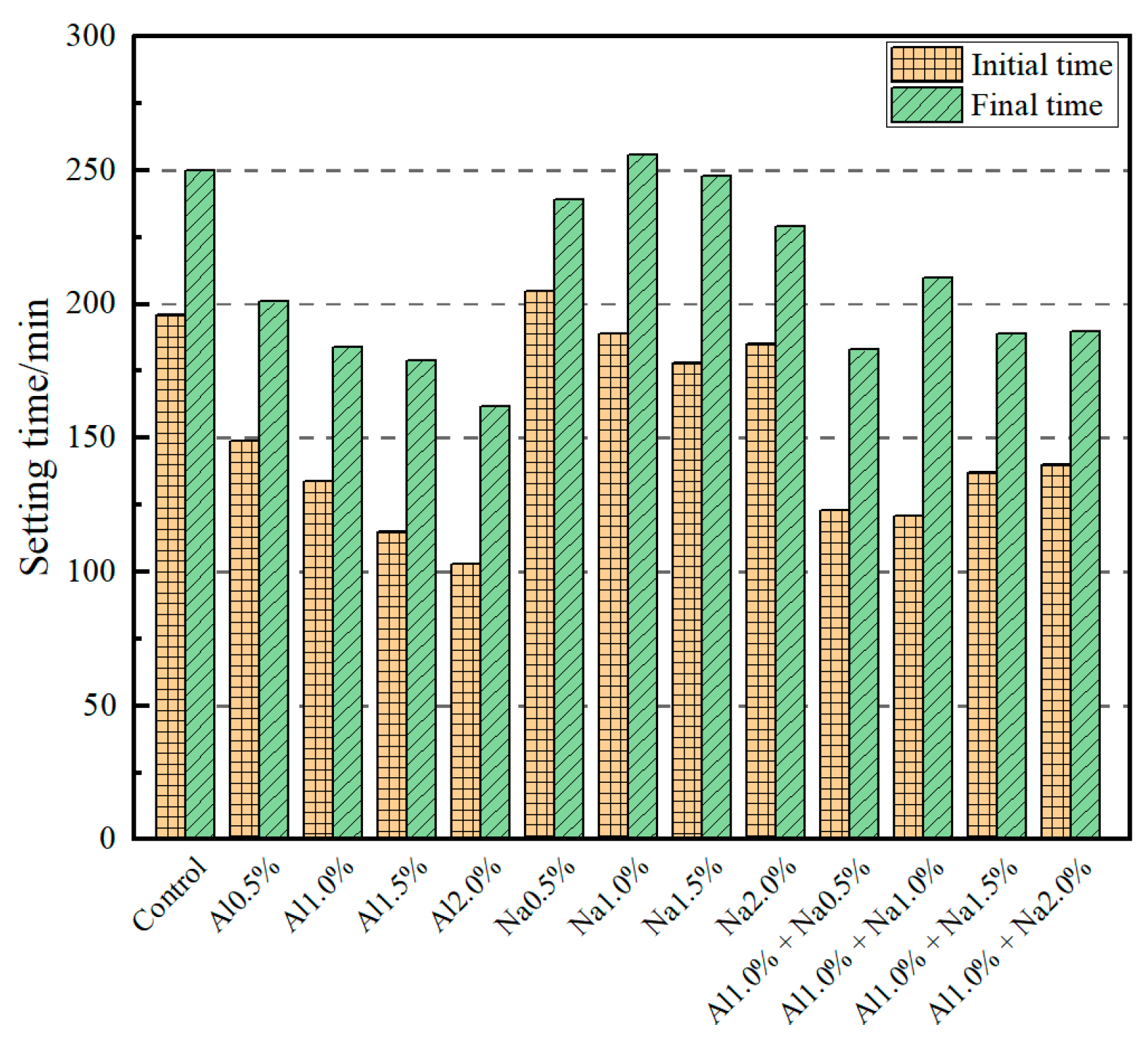


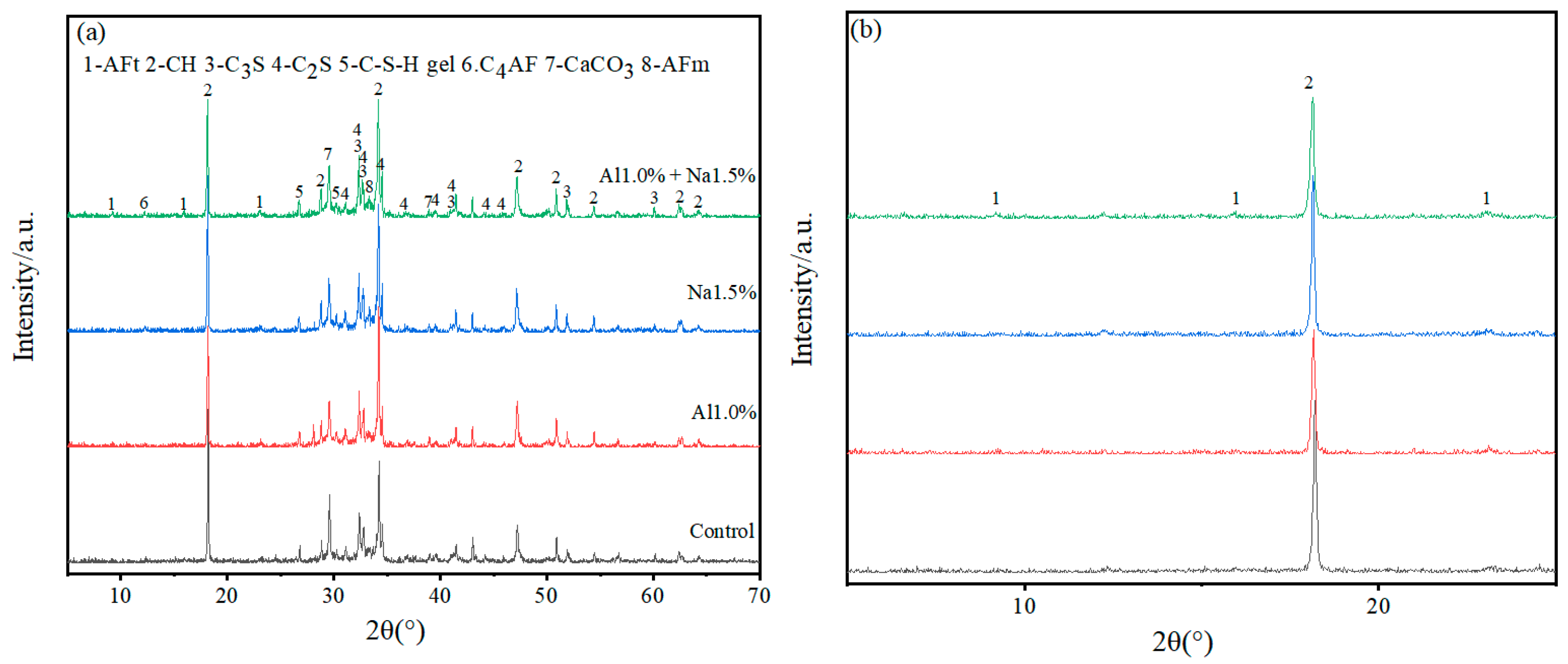
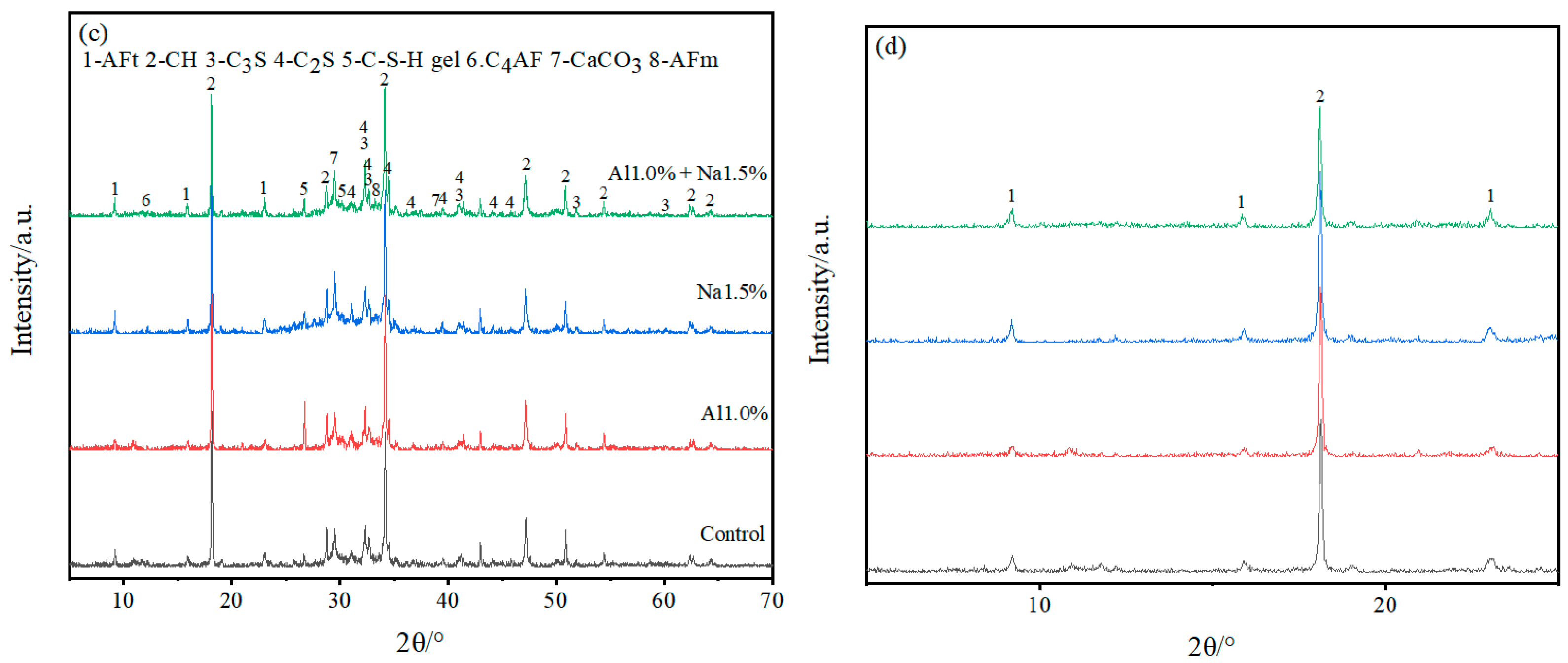
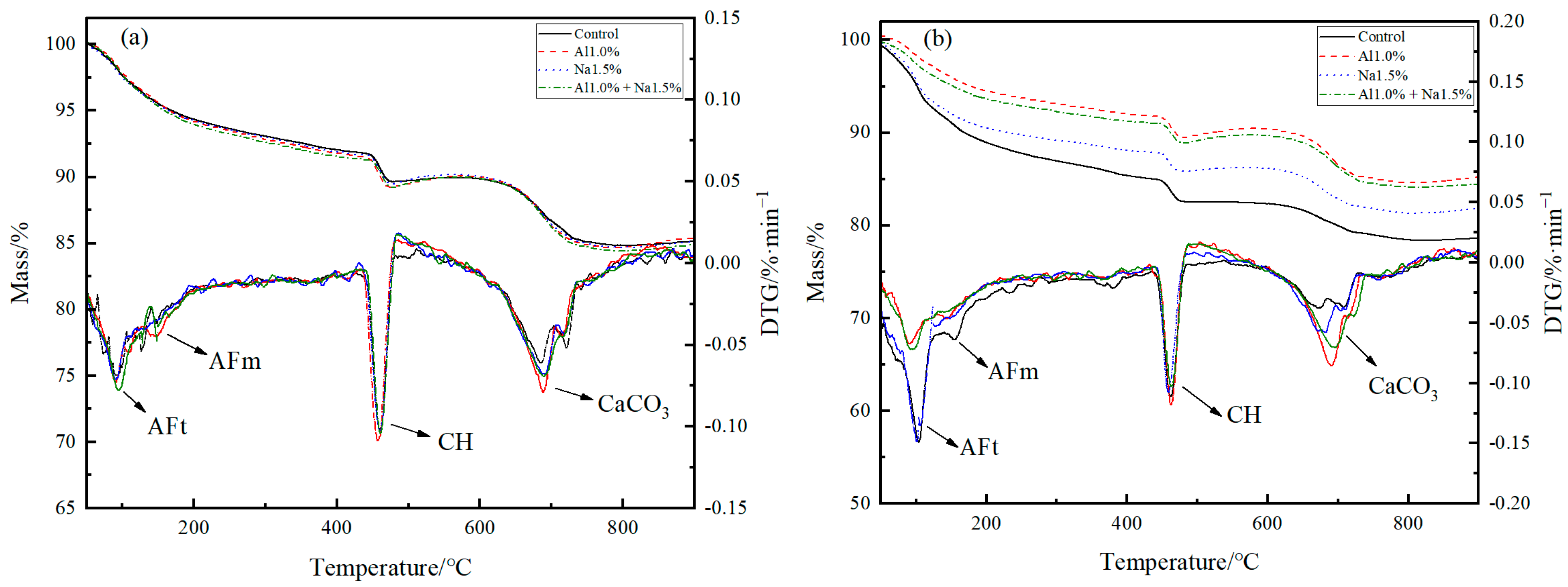
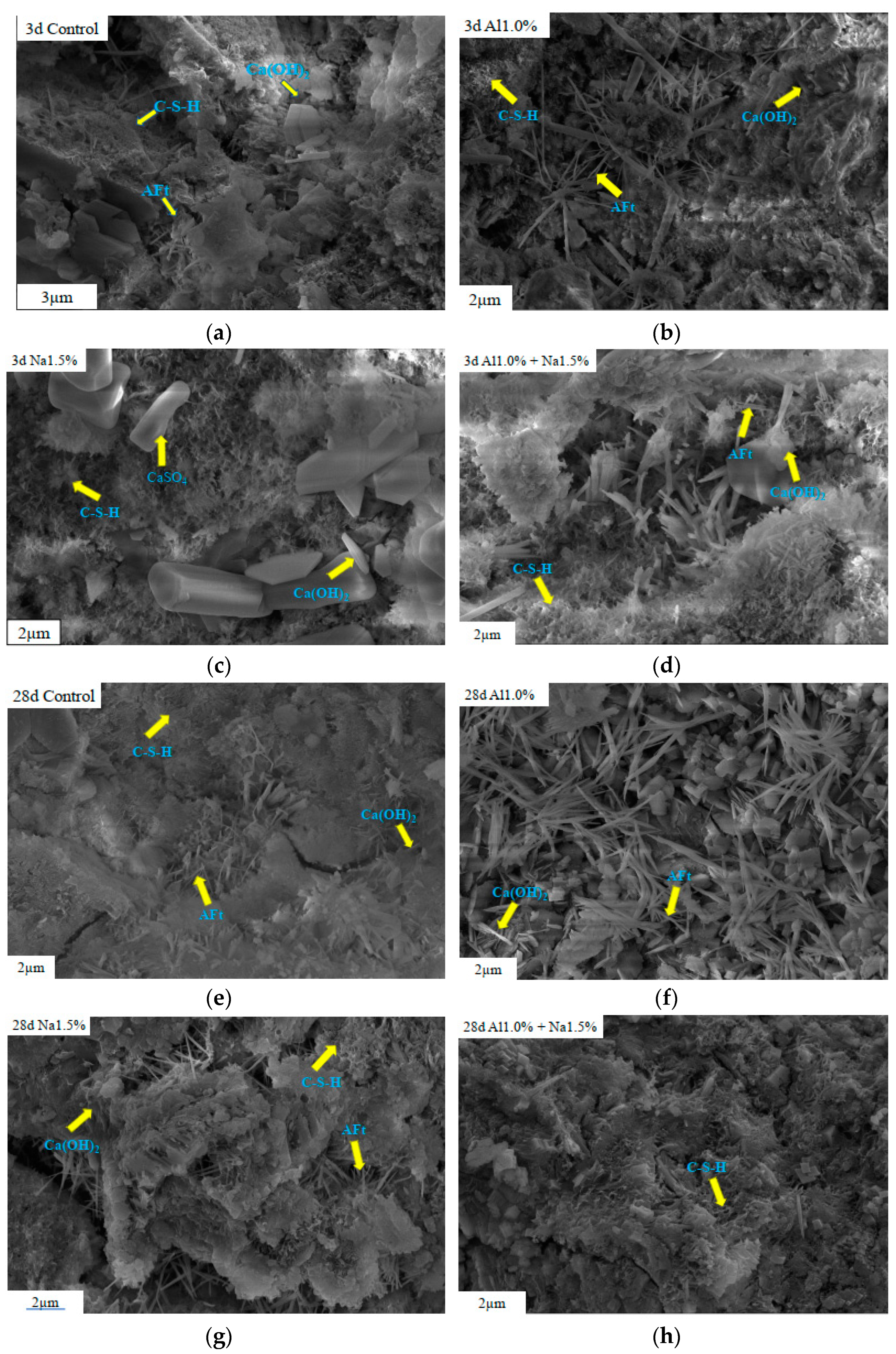

| Fineness/% | SSA (m2/kg) | Stability | Setting Time /Min | Flexural Strength/MPa | Compressive /MPa | |||
|---|---|---|---|---|---|---|---|---|
| Initial | Final | 3 d | 28 d | 3 d | 28 d | |||
| 0.8 | 366 | qualified | 200 | 250 | 6.0 | 9.5 | 30.1 | 50.5 |
| CaO | SiO2 | Al2O3 | Fe2O3 | MgO | SO3 | Na2O | K2O | Loss |
|---|---|---|---|---|---|---|---|---|
| 61.86 | 23.17 | 5.37 | 3.32 | 2.78 | 2.36 | 0.36 | 0.20 | 0.13 |
| C3S | C2S | C3A | C4AF | Gypsum | Calcite | Amorphous |
|---|---|---|---|---|---|---|
| 58.68 | 15.03 | 9.34 | 7.80 | 2.65 | 3.62 | 2.88 |
| Groups | Al2(SO4)3·18H2O 1/% | Na2SO4 1/% | Cement/g | Water/g |
|---|---|---|---|---|
| Control | - | - | 500 | 200 |
| Al0.5% | 0.5 | - | 500 | 200 |
| Al1.0% | 1.0 | - | 500 | 200 |
| Al1.5% | 1.5 | - | 500 | 200 |
| Al2.0% | 2.0 | - | 500 | 200 |
| Na0.5% | - | 0.5 | 500 | 200 |
| Na1.0% | - | 1.0 | 500 | 200 |
| Na1.5% | - | 1.5 | 500 | 200 |
| Na2.2% | - | 2.0 | 500 | 200 |
| Al1.0% + Na0.5% | 1.0 | 0.5 | 500 | 200 |
| Al1.0% + Na1.0% | 1.0 | 1.0 | 500 | 200 |
| Al1.0% + Na1.5% | 1.0 | 1.5 | 500 | 200 |
| Al1.05 + Na2.0% | 1.0 | 2.0 | 500 | 200 |
| No. | mAFt/% | mH/% | mCC/% | mCH/% |
|---|---|---|---|---|
| Control | 10.27 | 2.37 | 4.85 | 16.28 |
| Al1.0% | 10.81 | 2.02 | 4.86 | 15.53 |
| Na1.5% | 10.21 | 2.02 | 5.14 | 16.17 |
| Al1.0% + Na1.5% | 11.33 | 1.84 | 5.18 | 15.85 |
| No. | mAFt/% | mH/% | mCC/% | mCH/% |
|---|---|---|---|---|
| Control | 18.96 | 3.33 | 3.89 | 16.24 |
| Al1.0% | 10.93 | 1.90 | 5.32 | 16.30 |
| Na1.5% | 17.45 | 2.22 | 4.44 | 15.02 |
| Al1.0% + Na1.5% | 11.15 | 1.75 | 5.31 | 15.95 |
| Groups | Average Pore Size (µm) | Porosity (%) | Proportion of Pore Size (%) | |||
|---|---|---|---|---|---|---|
| ≤20 nm | 20~50 nm | 50~200 nm | ≥200 nm | |||
| Control | 0.03444 | 50.1 | 16.0 | 24.7 | 54.5 | 3.1 |
| Al1.0% | 0.03183 | 61.4 | 19.0 | 22.1 | 53.4 | 5.5 |
| Na1.5% | 0.03198 | 48.2 | 16.8 | 27.8 | 53.3 | 2.3 |
| Al1.0% + Na1.5% | 0.01736 | 36.1 | 45.7 | 36.3 | 11.9 | 5.8 |
Publisher’s Note: MDPI stays neutral with regard to jurisdictional claims in published maps and institutional affiliations. |
© 2022 by the authors. Licensee MDPI, Basel, Switzerland. This article is an open access article distributed under the terms and conditions of the Creative Commons Attribution (CC BY) license (https://creativecommons.org/licenses/by/4.0/).
Share and Cite
Wang, Y.; Sun, L.; Liu, S.; Li, S.; Guan, X.; Luo, S. Development of a Novel Double-Sulfate Composite Early Strength Agent to Improve the Hydration Hardening Properties of Portland Cement Paste. Coatings 2022, 12, 1485. https://doi.org/10.3390/coatings12101485
Wang Y, Sun L, Liu S, Li S, Guan X, Luo S. Development of a Novel Double-Sulfate Composite Early Strength Agent to Improve the Hydration Hardening Properties of Portland Cement Paste. Coatings. 2022; 12(10):1485. https://doi.org/10.3390/coatings12101485
Chicago/Turabian StyleWang, Yuli, Luyi Sun, Songhui Liu, Shuaijie Li, Xuemao Guan, and Shuqiong Luo. 2022. "Development of a Novel Double-Sulfate Composite Early Strength Agent to Improve the Hydration Hardening Properties of Portland Cement Paste" Coatings 12, no. 10: 1485. https://doi.org/10.3390/coatings12101485
APA StyleWang, Y., Sun, L., Liu, S., Li, S., Guan, X., & Luo, S. (2022). Development of a Novel Double-Sulfate Composite Early Strength Agent to Improve the Hydration Hardening Properties of Portland Cement Paste. Coatings, 12(10), 1485. https://doi.org/10.3390/coatings12101485






